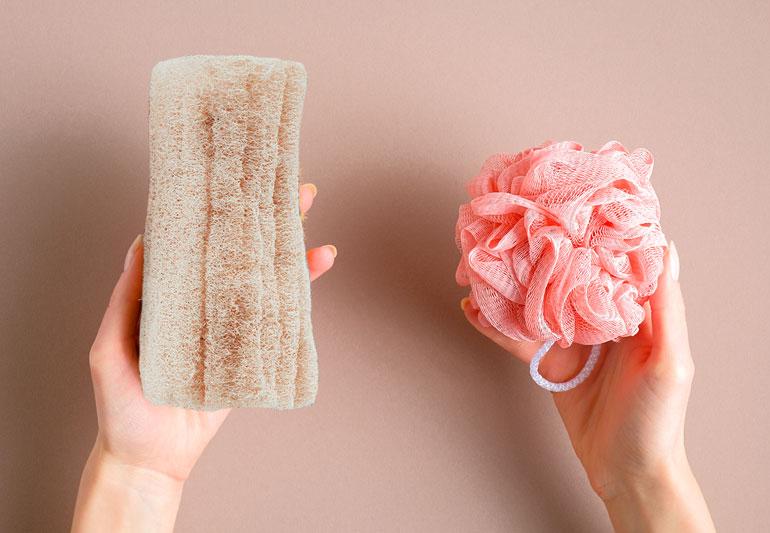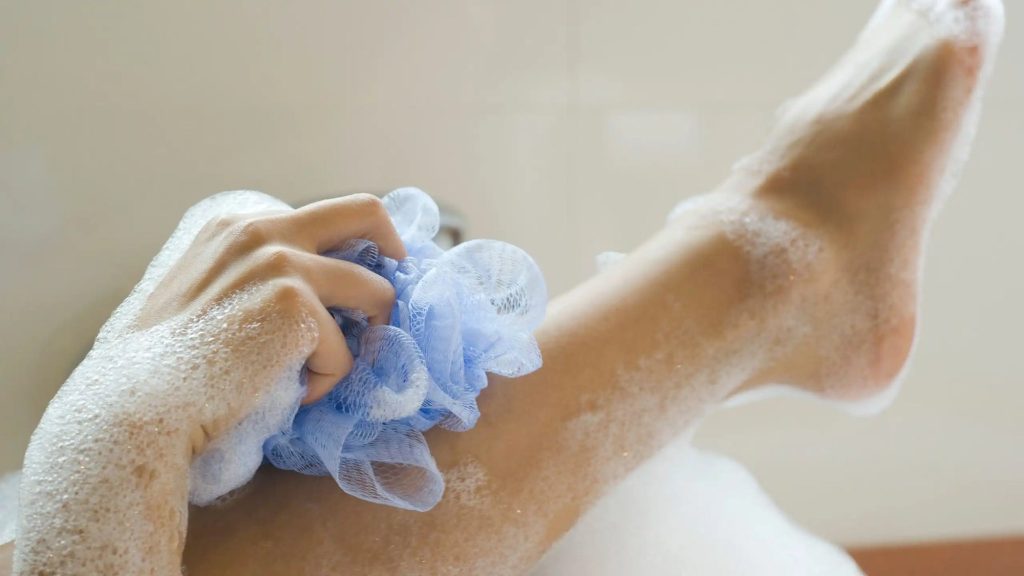Your bath pouf is more than just a shower accessory—it’s a key part of your daily routine that helps keep your skin clean and smooth. But have you ever stopped to think about how often you should replace it?
Using an old bath pouf can actually harm your skin by harboring bacteria and grime. If you want to avoid skin irritation and keep your shower fresh, it’s important to know the right time to swap it out. Keep reading to find out the simple signs that tell you when it’s time to say goodbye to your bath pouf and how to keep your skin healthy every day.

Credit: health.clevelandclinic.org
Signs To Replace Bath Pouf
Knowing when to replace your bath pouf is key to keeping your skin clean and healthy. Bath poufs can harbor bacteria and lose their effectiveness over time. Watch out for these clear signs that your bath pouf needs a swap.
Visible Wear And Tear
If your bath pouf looks frayed, torn, or has started falling apart, it’s time to replace it. The mesh material breaks down with use and can trap dirt in the damaged areas. Using a worn-out pouf won’t clean your skin properly and might even irritate it.
Persistent Odors
Have you noticed a bad smell coming from your pouf even after rinsing it? This usually means bacteria and mildew have taken hold. No amount of washing can fix this smell, so holding onto a smelly bath pouf can do more harm than good.
Reduced Lathering
Does your bath pouf struggle to create bubbles like it used to? Over time, soap residue builds up and clogs the mesh, reducing lather. When you notice less foam, it’s a sign your pouf isn’t working well and should be replaced to maintain a refreshing shower experience.

Credit: www.homeanddecor.com.sg
Health Risks Of Old Bath Poufs
Old bath poufs can hide more than just dirt. They often become a breeding ground for harmful germs. Using a worn-out pouf may lead to health issues. Understanding these risks helps you keep your skin safe and healthy.
Bacterial Growth
Bath poufs stay wet after every use. This dampness creates a perfect place for bacteria to grow. Bacteria multiply quickly on old poufs. Touching these bacteria can cause infections and unpleasant odors. Regularly replacing your pouf reduces this risk.
Fungal Infections
Fungi thrive in warm, moist environments. An old pouf often becomes a home for fungi. This can cause infections like athlete’s foot or ringworm. These infections cause itching and redness on your skin. Clean and replace your pouf often to avoid fungal growth.
Skin Irritations
Old poufs collect dead skin cells and soap residue. These build-ups can irritate sensitive skin. They may cause redness, itching, or rashes. Using a fresh pouf helps keep your skin smooth and healthy. Change your bath pouf regularly to prevent irritation.
Recommended Replacement Frequency
Keeping your bath pouf in top condition is essential for maintaining healthy skin. But how often should you actually replace it? Understanding the recommended replacement frequency can make a significant difference in your skincare routine. Let’s dive into some practical guidelines to ensure your bath pouf remains a hygienic and effective tool.
General Guidelines
Generally, experts suggest replacing your bath pouf every three to four weeks. This frequency helps prevent bacteria and mold buildup, which can lead to skin irritations. Think of it as a small but vital step towards maintaining a cleaner and healthier shower routine.
Factors Affecting Replacement
Several factors can influence how often you should change your bath pouf. If you shower more than once a day, consider replacing it more frequently. Humid environments can also speed up bacterial growth, necessitating more frequent changes.
Additionally, if you notice any signs of wear and tear, such as fraying or discoloration, it’s time to switch it out. Remember, a clean and intact pouf is more effective in exfoliating your skin.
Seasonal Considerations
Seasonal changes can impact how often you should replace your bath pouf. In warmer months, when sweat and oil production increase, replacing your pouf more often can help maintain skin freshness. Conversely, during colder months, you might find the frequency could be slightly extended.
Do you ever notice how your skin’s needs change with the seasons? Adjusting your bath pouf replacement schedule accordingly can help address these shifts effectively.
Proper Care To Extend Life
Taking good care of your bath pouf can significantly extend its life, saving you money and reducing waste. A pouf that dries properly, stays clean, and is stored well will remain fresh and effective for longer. Are you curious about the small changes in your routine that make a big difference?
Drying Techniques
After each use, squeeze out excess water from your bath pouf gently—avoid twisting as it can damage the fibers.
Hang it in a well-ventilated area where air circulates freely. Avoid leaving it in a damp shower corner, as this encourages mold and mildew growth.
Consider using a hook or a dedicated pouf hanger to keep it elevated and dry quickly. Have you noticed how quickly some poufs stay fresh compared to others? Drying habits make that difference.
Cleaning Methods
Wash your bath pouf regularly to remove soap scum, dead skin, and bacteria. You can soak it in warm water mixed with a small amount of white vinegar or baking soda for 10-15 minutes.
For a deeper clean, toss it in your washing machine inside a laundry bag on a gentle cycle with mild detergent. Avoid bleach, as it weakens the mesh material.
Rinsing thoroughly after each use also helps prevent buildup. How often do you think you should clean your pouf to keep it safe?
Storage Tips
Store your bath pouf somewhere dry and airy between uses, not in a closed container or plastic bag. This prevents moisture from being trapped inside.
If you have multiple poufs, give each its own space to avoid crushing and to allow airflow.
Keeping your pouf away from direct sunlight also helps maintain its color and texture longer. Where do you currently keep your bath pouf after showering?
Alternatives To Traditional Bath Poufs
Traditional bath poufs are popular but not the only option for cleansing. Many alternatives offer different textures, materials, and benefits. These choices can suit sensitive skin or help reduce waste. Explore natural and synthetic options to find what fits your routine best.
Natural Sponges
Natural sponges come from the sea and are biodegradable. They feel soft on the skin and create a gentle lather. These sponges are durable but need proper drying to avoid mold. They offer a natural way to exfoliate without harsh scrubbing.
Silicone Scrubbers
Silicone scrubbers are easy to clean and dry quickly. They resist bacteria growth and last a long time. Their soft bristles massage skin gently while cleansing. Silicone scrubbers are ideal for those who want a hygienic, low-maintenance option.
Washcloths And Loofahs
Washcloths are simple and reusable, made from cotton or microfiber. They are gentle and easy to wash after use. Loofahs are natural plant fibers that exfoliate skin effectively. Both provide eco-friendly choices with good texture variety.

Credit: rawsugarliving.com
Frequently Asked Questions
How Often Should You Replace Your Bath Pouf?
Replace your bath pouf every 3 to 4 weeks to prevent bacteria buildup. Regular replacement ensures hygiene and skin safety.
Why Is Frequent Bath Pouf Replacement Important?
Frequent replacement avoids mold, mildew, and bacteria growth. It keeps your skin healthy and prevents infections.
Can A Bath Pouf Be Cleaned Instead Of Replaced?
Cleaning helps but doesn’t remove all bacteria. Replacement is safer to maintain proper hygiene and skin care.
What Signs Indicate It’s Time To Replace A Bath Pouf?
Foul odor, discoloration, or fraying means replace it. These signs show bacteria and wear, risking your health.
Conclusion
Replacing your bath pouf regularly keeps your skin healthy and clean. Aim to change it every three to four weeks. This helps stop bacteria and mold from growing. A fresh pouf feels soft and works better with soap. Remember, small steps can make a big difference in your daily routine.
Keep your bath pouf fresh, and enjoy a cleaner, safer shower every time. Simple care leads to better hygiene and a pleasant bathing experience.





